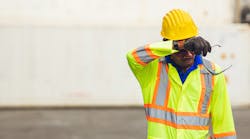How Workers can Keep Their Cool with Safety Technology
Key Highlights
- Heat waves are occurring more frequently than they used to—and for longer portions of the year.
- Businesses need to explore new technologies and tools that can better monitor workers in the heat.
- Regardless of any forthcoming federal OSHA rules or regulations, a responsibility to protect workers means that employers must find new ways to keep workers cool.
Even with summer behind us, the heat isn’t dying down anytime soon. Across much of the globe—and certainly here in the United States—heat waves are lasting longer, striking earlier in the year, and stretching well into the fall. According to the U.S. Environmental Protection Agency (EPA), heat waves are occurring more often than they used to, with their frequency climbing from an average of two per year during the 1960s to six per year during the 2010s and now the 2020s.
The season itself is expanding as well. The average heat wave season today is about a month and a half (46 days) longer than it was 50 years ago. The timing is changing, too—and with severe consequences: Heat waves arriving in early spring or late fall can catch people off guard, exposing them to risks they might not be prepared to manage. These shifting conditions are not just a public health concern; they are a workplace safety issue, especially in labor-intensive industries, such as construction, mining and manufacturing.
For workers who spend hours outdoors or near heat-producing equipment, the threat of overheating is real—and often underestimated. That reality is forcing organizations to rethink how they approach worker safety. At the federal level, the Occupational Safety and Health Administration (OSHA) has been developing a national heat standard to better protect workers from heat stress, and several states have already enacted their own rules. In California, for example, Title 8, Section 3395 of the California Code of Regulations requires employers to take specific steps to protect outdoor workers from heat-related illness.
Traditional heat stress training and personal protective equipment (PPE) requirements remain essential, but they’re no longer sufficient on their own. Rising temperatures, longer heat waves and increasingly unpredictable weather patterns can expose gaps that standard safety practices may not fully address.
To combat the evolving risks of heat exposure, companies are increasingly turning to intelligent security systems (e.g., sensors, thermal imaging and real-time monitoring systems) that can proactively assess working conditions, detect danger and alert employees before a situation escalates. These advancements don’t just reduce the risk of heat-related illnesses; they help foster a safer, more resilient workforce.
Technology that Protects Workers
The workers most vulnerable to heat-related illness are often those who uphold our nation’s critical infrastructure: construction crews laboring on highways and buildings, welders managing intense flames, electricians working in enclosed spaces or miners operating deep underground. These individuals keep society moving, but they are also among the most exposed to extreme conditions.
In recognition of these dangers, OSHA recently launched a campaign to improve awareness and provide tools for heat illness prevention in workplaces. The campaign emphasizes education and encourages both employers and employees to recognize the warning signs of heat stress and dehydration. But awareness alone cannot solve the problem. Organizations need tools that can reinforce safety even when a member of the EHS team isn’t on the jobsite.
That’s where modern security technology comes in. Cameras, sensors and wearables aren’t simply passive devices; they are intelligent security systems capable of gathering and analyzing data to create a fuller picture of safety practices that are—or are not—being observed.
Technology can mimic our senses to detect potentially dangerous conditions. Cameras can hear by processing audio, smell via environmental sensors, and touch through thermal or vibration sensing.
Wearables add another layer of protection. Smart vests, helmets or wristbands can monitor body temperature, heart rate or even environmental conditions in the immediate area. When a worker’s biometrics signal distress, alerts can be sent instantly to supervisors and co-workers, enabling rapid intervention. These technologies operate like a modern-day canary in the coal mine.
Technology in Action
While these technologies have been proven to help workers in the heat, which increases the risk of injury to workers, the applicability goes far beyond protecting workers in hot environments. Using analytics on the edge, organizations now have the processing power to have their cameras and sensor capabilities make meaningful differences in real-time—regardless of the weather.
Focusing on mandatory PPE is a great place to start, particularly during hot seasons where workers may forgo an important piece of equipment to try and stay cool. Cameras can identify whether a worker is wearing the proper protective gear and can flag noncompliance for a safety professional’s intervention.
This is a straightforward application, but strides in security technology have led to even more use cases, specifically in thermal imaging and improved sensors. For instance, thermal cameras positioned near heat-producing equipment can detect when a surface has reached dangerous temperatures. Instead of a worker accidentally touching an overheated machine, the system can send an alert that prevents a burn before it happens.
These examples show how intelligent safety systems can help organizations proactively manage heat risks and related hazards before they escalate. In other words, the value is not surveillance for surveillance’s sake. These systems are designed for protection, ensuring workers can do their jobs with confidence that risks are being actively managed around them.
Technology for a Safer Tomorrow
The promise of intelligent security technology lies not just in preventing immediate harm, but in shaping a safer future through data-driven insights. The sensors and cameras deployed across a worksite are more than tools for compliance; they are enablers of predictive safety strategies.
Artificial intelligence (AI) and deep learning make this possible. When analytics are embedded directly into cameras or monitoring devices, organizations can collect and process vast amounts of data at the “pixel level.” Each data point tells a small part of the story: a subtle rise in surface temperature, a gradual increase in heart rate or a sudden shift in air quality. On their own, these details might seem insignificant. But when aggregated and analyzed through AI models, patterns emerge.
By observing those patterns, organizations can shift from reactive to proactive. Instead of responding to an accident after it happens, they can predict the conditions most likely to lead to one—and take steps to prevent it. Being able to forecast tomorrow’s weather has long been an important part of outdoor work safety. Now, with the right technology in place, organizations can also forecast tomorrow’s risks for each worker, each shift and each task. Prediction of danger equals the avoidance of danger.
Technology for Every Season
As heat waves grow longer and more frequently, the safety of labor-intensive industries will depend on more than traditional training or PPE. Proactive detection through advanced security technology offers organizations a powerful way to safeguard their workers. By integrating cameras, sensors, wearables and AI-driven analytics, businesses can improve PPE compliance, identify hazards in real-time and strengthen incident reporting protocols.
Ultimately, these systems do more than react to emergencies; they create a culture of prevention. Workers can step onto jobsites knowing that risks are being monitored constantly and intelligently, not just by their supervisors but by technology designed to enhance human capability.
The summer heat may no longer be confined to the summer months, but with the right tools in place, organizations can ensure that their people stay safe, protected and resilient—no matter how high the temperature climbs.
Read more:
About the Author
Joe Morgan
Joe Morgan is the business development manager for critical infrastructure at Axis Communications. In this capacity, he is responsible for developing strategies and building channel relationships to expand Axis’ presence in markets specific to critical infrastructure in North America. He has more than 32 years of experience building market share in the critical infrastructure industry.





